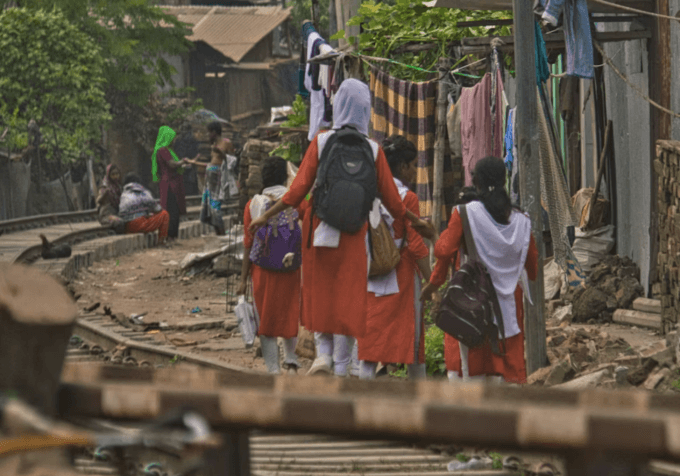






























































Photo by Tanvir Ahmed Rahat
Statistics can be fairly deceptive. At least, this is suggested by latest estimates released by World Bank, according to which India’s extreme poverty rate dropped to 5.3% in 2022-23 from 27.1% in 2011-12. The picture of India having succeeded in pulling around 269 million people above the international poverty threshold in around a decade’s time is, however, not as rosy as it seems to be. The usage of the word “extreme” strongly suggests that a significant number are apparently still on/below the poverty line. Strong critics have also taken note of this by pointing out to “Thali Index.” “Thali” is the term used for a meal in India. As per a study, the poor in India, counted apparently, above the extreme poverty rate, cannot afford two vegetarian meals a day. Forty percent of this country’s rural population cannot afford two vegetarian meals a day and 80% cannot afford one vegetarian and one non-vegetarian meal/thali daily. In urban areas, 10% cannot afford two vegetarian meals and 50% cannot afford one vegetarian and one non-vegetarian meal. When a significant percent of the country’s population doesn’t have enough to afford two proper meals daily, it seems a little difficult the view these having been lifted above the so-called “poverty” rate.
There is yet another angle which cannot be de-linked from actual factors suggestive of problems the poor in India are still suffering from. Thali-index marks their being deprived of adequate meals and/or nutrition. India still continues to suffer from problems linked with unemployment and also under-employment. Unemployment rate in urban areas is 6.5% and 4.5% in rural areas, the overall unemployment rate in India being 5.1%. The youth (15-29 years) suffer from a unemployment rate of 13.8%. India has the largest population – 1.4 billion or 143.81 crore. This implies unemployment even among a percentage of this country’s population may be viewed as a major economic problem for the country as a whole.
Notwithstanding the claims made about India’s economic progress, unemployment among the literate, semi-literate, illiterate in rural as well as urban areas also suggests that enough attention is apparently not being paid to creating employment opportunities for these sections. Unemployment or lack of jobs is also a pointer to a substantial number being without pay-checks or any/adequate source of income to contribute to their own as well as their families’ earnings. Clearly, while taking “pride” in India having “lifted” a substantial percentage of population above the “extreme” poverty rate, some attention also needs to paid to other factors responsible for probably contributing to the same.
In addition, another grim face of “extreme poverty” cannot be ignored. This includes agricultural laborers committing suicide. In 2021, around 5,563 agricultural laborers committed suicide, which was a 9% increase from 2020 and 29% from 2019. Abject poverty, failure to earn to eat and feed their families may be viewed as a cause of their being forced to commit suicide.
At the time of feeling “great” about some Indians being no longer extremely poor, some attention needs to be paid to others still trapped in it and hard reality of more being pushed towards it. Yes, the latter point refers to frenzy being displayed in certain parts of the country, including capital city- New Delhi- to demolition of slums. Slums are cluster of houses, with several living under the same roof, lacking some basic necessities. Indian slums tend to be without adequate sanitation facilities, proper water supply and more. More than 41% of Indian urban population lived in slums in 2022. The key motive of political leaders paying extra attention nowadays to demolition-move is that of beautifying the city and perhaps making it looking “richer.” Inhabitants of slums are primarily migrant workers, who have moved from rural areas to cities in search of a living. Yet, within the past few weeks, the “demolition” drive of a few slums has left a significant number homeless and jobless with nowhere to go. Of course, authorities have claimed that quite a few have been given accommodation in other areas.
Larger population of India still resides in rural areas. Here too, the poor remain deprived of basic amenities such as electricity, water supply, etc. Unfortunately, there are no specific statistics regarding the number of poor living in rural slums. Nevertheless, the fact that they remain a strong challenge for the country’s development has been taken note of by a few observers. When the poor are deprived of proper meals, the question of their affording good education for their children doesn’t prevail. In urban areas, to a certain degree, even people living in slums are giving importance to ensuring basic education to their children. In quite a few rural areas, proper educational facilities do not exist.
News about India set to overtake Japan as the fourth largest economy would be viewed as one signaling country’s actual economic development if it spelt some economic relief for majority of Indians. The situation doesn’t suggest this at the present. Not at least till a few rich continue to grow richer, increasing the gap between rich and poor and the latter growing poorer.
When challenges combatting the majority in India, from unemployment, lack of basic amenities, threat of their houses being demolished or being actually razed to ground and more are taken note of, each is a pointer to the hard reality- that of bleak future for those already facing hard circumstances. In essence, these certainly are not suggestive of their being raised above their present economic status. They certainly cannot be counted among those who seem to have been raised above the index of extreme poverty. They still have a long way to go. Role of political rhetoric for them, sounding louder than ever during election times, may perhaps be viewed as just a mirage. And even a mirage bears no importance against threat of bulldozers!
The post Indian Economy is Moving “Ahead,” Leaving Poor Behind! appeared first on CounterPunch.org.
This post was originally published on CounterPunch.org.